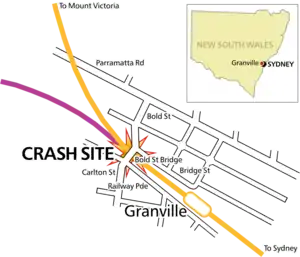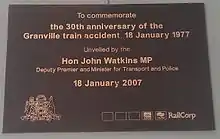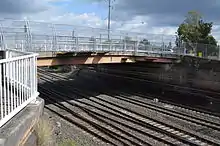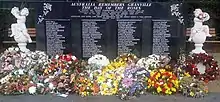Granville rail disaster
The Granville rail/train disaster occurred on Tuesday 18 January 1977 at Granville, New South Wales, a western suburb of Sydney, when a crowded commuter train derailed, running into the supports of a road bridge that collapsed onto two of the train's passenger carriages. The official enquiry found the primary cause of the crash to be poor fastening of the track.
| Granvil | |
|---|---|
 | |
| Details | |
| Date | 18 January 1977 08:10 |
| Location | Granville, New South Wales 19.06 km (11.84 mi) WNW from Sydney |
| Country | Australia |
| Line | Main Western line |
| Operator | Public Transport Commission |
| Incident type | Derailment |
| Cause | Poor track maintenance |
| Statistics | |
| Trains | 1 |
| Deaths | 83 (84 as of 2017) |
| Injured | 213 |
It remains the worst rail disaster in Australian history and the greatest loss of life in a confined area post-war: 83 people died, more than 213 were injured, and 1,300 were affected.[1] An 84th victim, an unborn child, was added to the fatality list in 2017.[2]
Disaster
The train involved in the disaster consisted of eight passenger carriages hauled by 46 class electric locomotive 4620, and had commenced its journey towards Sydney from Mount Victoria in the Blue Mountains at 6:09 am.[3] At approximately 8:10 am it was approaching Granville railway station when the locomotive derailed and struck one of the steel-and-concrete pillars supporting the bridge carrying Bold Street over the railway cutting.
The derailed engine and first two carriages passed the bridge. The first carriage broke free from the other carriages. Carriage one was torn open when it collided with a severed mast beside the track, killing eight passengers. The remaining carriages came to a halt with the second carriage clear of the bridge. The rear half of the third carriage, and forward half of the fourth carriage came to rest under the weakened bridge, whose weight was estimated at 570 tonnes (560 long tons; 630 short tons).[4] Within seconds, with all its supports demolished, the bridge and several motor cars on top of it crashed onto the carriages, crushing them and the passengers inside.[5]

Of the total number of passengers travelling in the third and fourth carriages, half were killed instantly when the bridge collapsed on them, crushing them in their seats.[4] Several injured passengers were trapped in the train for hours after the accident, with part of the bridge crushing a limb or torso. Some had been conscious and lucid, talking to rescuers, but died of crush syndrome soon after the weight was removed from their bodies. This resulted in changes to rescue procedures for these kinds of accidents. Rescuers also faced greater difficulties as the weight of the bridge was still crushing the affected carriages, reducing the space in which they had to work to get survivors out, until it was declared that no one was allowed to attempt further entry until the bridge had been lifted. Soon after, the bridge settled a further two inches onto the train, trapping two rescuers and crushing a portable generator "like butter".[6]
Another danger came from gas; LPG cylinders were kept year-round on board the train to be used in winter for heating.[7] Several people were overcome by gas leaking from ruptured cylinders. The leaking gas also prevented the immediate use of powered rescue tools. The NSW Fire Brigade provided ventilation equipment to dispel the gas and a constant film of water was sprayed over the accident site to prevent the possibility of the gas igniting.[4]
The train driver, the assistant crewman, the "second man", and the motorists driving on the fallen bridge all survived. The operation lasted from 8:12 am Tuesday until 6:00 am Thursday. Ultimately, 84 people were killed in the accident, which included an unborn child.
Aftermath
The bridge was rebuilt as a single span without any intermediate support piers. Other bridges similar to the destroyed bridge had their piers reinforced.

The original inquiry into the accident found that the primary cause of the crash was "the very unsatisfactory condition of the permanent way", being the poor fastening of the track, causing the track to spread and allowing the left front wheel of the locomotive to come off the rail. Other contributing factors included the structure of the bridge itself. When built, the base of its deck was found to be one metre lower than the road. Concrete was added on top to build the surface up level with the road. This additional weight significantly added to the destruction of the wooden train carriages. The disaster prompted substantial increases in rail-maintenance expenditure.[8] The train driver, Edward Olencewicz, was exonerated by the inquiry.
For 39 years, the people of the disaster had little to say until the Granville Train Disaster Association Inc. was formed. This was to represent the emotions of those affected (including relatives and friends) via Barry J Gobbe OAM JP and Meredith Knight JP to the Minister for Transport, Andrew Constance and New South Wales Premier, Gladys Berejiklian and requested an apology for the way the real people of the disaster were treated by the then Wran Government of the day. On 4 May 2017 Berejiklian gave a formal apology to the victims of the disaster, in New South Wales Parliament House.[9]
Memorial

Families and friends of the victims and survivors gather with surviving members of the rescue crews annually.[10] The ceremony ends with the throwing of 84 roses on to the tracks to mark the number of passengers killed.[11] In 2007, a plaque was placed on the bridge to mark the efforts of railway workers who assisted in rescuing survivors from the train.[11]
The original group, known as 'the trust', made submissions on rail safety issues, including recommending that fines for safety breaches be dedicated to rail safety improvements,[12] and campaigning for the establishment of an independent railway safety ombudsman.[13]
In media
- A television docudrama, The Day of the Roses, was produced in 1998 about the accident.
- The Granville Train Disaster: 35 Years of Memories - a 2011 book by B. J. Gobbe, an emergency worker who attended the incident.[14]
- A television documentary, The Train, produced by Graham McNeice was aired in 2012 on The History Channel Australia about the accident, and narrated by Brian Henderson.[15]
- Revisiting the Granville Train Disaster of 1977 - a 2017 book by B. J. Gobbe.[16]
See also
- Lewisham rail crash (United Kingdom)
- Eschede train disaster (Germany)
- Railway accidents in New South Wales
- Lists of rail accidents
References
- "The rail disaster that changed Australia". BBC News. 17 January 2017. Retrieved 26 January 2020.
- "Unborn child victim remembered at Granville memorial after 40 years".
- "Granville Rail/Train Disaster". Granville History. Archived from the original on 28 May 2016. Retrieved 6 May 2016.
- "Danger Ahead! Granville, Sydney, Australia (2)". Retrieved 30 December 2016.
- "Medical Review Seminar Lidcombe Hospital −15 February 1977". Granville Historical Society. 24 October 2007. Archived from the original on 27 December 2003. Retrieved 20 March 2008.
- "Granville". Film Australia. 1977. Retrieved 28 October 2017.
- "True story of courage and compassion". 17 January 2013. Retrieved 30 December 2016.
- "Formal Investigation of an Accident on or about the Up Main Western Railway Line at Granville on 18th January 1977". www.records.nsw.gov.au. 22 December 2018. Retrieved 16 June 2019.
- "Granville: Mixed response as NSW Government apologises for Australia's worst train disaster". Australian Broadcasting Corporation. 4 May 2017. Retrieved 4 May 2017.
- "Granville victims remembered". Australian Broadcasting Corporation. 18 January 2007. Retrieved 10 January 2008.
- "Granville 41 years on". WSFM 101.7. 18 January 2018. Retrieved 10 January 2008.
- "Waterfall disaster fine low: opposition". National Nine News. 16 January 2007. Archived from the original on 5 June 2011. Retrieved 10 January 2008.
- "Rail safety election vow by Brogden". The Sydney Morning Herald. 18 January 2003. Retrieved 10 January 2008.
- Gobbe, Barry J. (2011). The Granville Train Disaster: 35 Years of Memories. Barry J. Gobbe. ISBN 978-0-646-55923-0.
- The way it is: Brian Henderson back for TV doco | The Sydney Morning Herald 12 December 2012. Retrieved 19 January 2016
- Gobbe, Barry J. (2017). Revisiting the Granville Train Disaster of 1977: A Re-examination of the Original Reports & Factual Data which was Never Been Questioned for Over 35 Years. Barry James & Associates. ISBN 978-1-876870-83-6.
External links
- Danger Ahead! Granville, Sydney, Australia
- Documentary on the Granville Train Disaster featuring Rescuer Gary Raymond & Survivor Paul Touzell(9 minute video)
- "Formal Investigation of an Accident on or about the Up Main Western Railway Line at Granville on 18th January 1977 – Summary of findings". NSW State Records. 11 May 1977.
- Granville Train Disaster Historians Web page